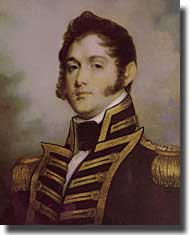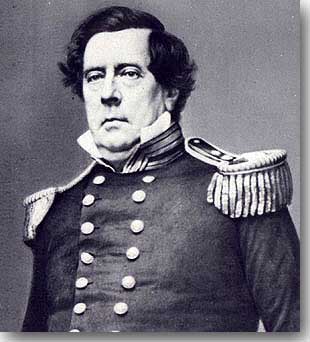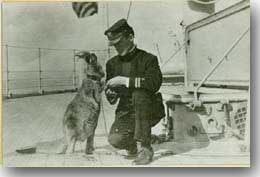|
Letters
Admiral Perry Tree Dear Mac, Your wonderful site came to my notice from Joe Malmendier in the US in response to a question from me about the Admiral Perry Tree and what a wonderful site it is. In spite of many attempts over the years I have not mastered the art of reading on a screen so I print off interesting articles, "file" them in the glove box of my car and read them as and when opportunity allows. My glove box will be filled to overflowing with your fascinating articles for weeks! Thank you very much! That's how retired army officers operate, perhaps we are not quite as quick as matelots! Judging from your career, which includes a tour as ADC to the GG around 1953, I would say we have met. You would have walked past me on several occasions following behind His Excellency as he inspected me! l was a Duntroon cadet 1952-1955, served 22 years then went into business in Canberra. A friend who resides on a small property at Boneo on Victoria's Mornington Peninsula asked me to research the origin of a large tree overlooking Port Phillip Bay near his property which is known as the Admiral Perry Tree. I have tried several lines of approach, each with its own peculiarities. First was to try and establish if, at America's entry to WW2, a ship or admiral of that name led the first US flotilla into the Bay. Second was to establish a link between the original Admiral Perry (Battle of Lake Erie and Opener of Japan in 1853) was linked to it. One of your articles, "The Genesis of the RAN" hints that this might be the one. My questions are:
Best Wishes
Now to your posed questions, no I do not know of the Admiral Perry tree on the Mornington Peninsula, and I am unable to unearth any reference to it. I did not actually state that Commodore Perry came to Port Phillip, he crept into Port Jackson with his four ships in 1839, causing much concern about our defence from marauding ships at that time. Now Peter, your reference to Commodore Perry at the Battle of Lake Erie and as the Commodore that opened up Japan to the world.
Commodore Oliver Hazard Perry of the 1813 Battle of Lake Erie fame.
By chance I have a small cushion bearing those famous words, which I bought at the US Naval Memorial in Washington, DC. The second Commodore Perry was Matthew Perry in Japan in 1853.
Commodore Matthew Perry, took four ships unannounced into Port Jackson 1839, There were four US naval ships all carrying the name Perry, a sailing Brig in 1843, and three destroyers, USS Perry ( DD-11 ) 1902-1919, USS Perry ( DD-340 ) 1920-1944, USS Perry ( DD-844 ) 1945-1970. None of these four ships ever visited Australia.
Photo USS Perry ( DD-11 1902/1919 )
USS Peary bombed and sunk in Darwin Harbour WW2
I thought that the US Great White Fleet that toured the world, and visited both Sydney and Melbourne in 1908 may have had an Admiral Perry in command, but not so. Here is a report of the Fleet in Sydney and Melbourne.
USS. Connecticut (BB-18). View taken c.August 1908, showing Lt. John E. Lewis, USN, with the kangaroo mascot presented to the ship by the citizens of Sydney, Australia, at the occasion of the U.S. Fleet's visit to that port during the round-the-world cruise, 1907-1908. NH 50477. There was an Admiral Peary who was a Polar explorer, and a US navy ship USS Peary, named after him. that was sunk by a Jap air raid in Dawin, but it never visited Melbourne. I have exhausted all my possibilities, without coming up with any thing about your Admiral Perry Tree, all very frustrating. I will send a few references about the Commodores and the ship USS Perry. Best Regards,
Thank you. My naval knowledge grows in leaps and bounds! I shared a Melbourne Cup luncheon today with Commander John Perrett, retired RAN engineer. We discussed the Admiral Perry Tree and he is very interested in your site, not having heard of it before, so you will have another visitor soon. I attend a long standing ex-Service officer lunch next Thursday and will take a few of your stories for distribution. There are a few keen historian members and they will visit soon too, I am sure. Thanks for your info and your help, especially the photos. Sooner or later I will get to the bottom of things Perry! All the best. Peter
Hi Alex and Mac, I think we have it, thanks to suggestions from you both. Rear Admiral Charles S. Sperry (not Perry) commanded The Great White Fleet of the US Navy which visited Australia in 1908. It arrived in Sydney on 20 August then sailed to Melbourne, arriving 29 August. This powerful fleet of 16 battle ships and 7 auxiliary ships manned by 14,000 sailors was sent around the world by President Roosevelt to establish clear recognition of America's sea power. The visit to Melbourne lasted a week, the fleet sailing for Albany WA on 5 September. During and prior to the Fleet's visit, Melbourne society celebrated in every conceivable way.... balls, race meetings, baseball matches, receptions, dances, picnics and so on. I suggest Mornington and district locals watched the Fleet's arrival through the Heads from a high spot overlooking Port Phillip Bay and enjoyed a picnic as it sailed up the Bay to Melbourne's official reception, then planted a tree to mark the great occasion. Choice of name would be either The Great White Fleet Tree or more simply, The Admiral Sperry Tree! Howzat?
While doing research on my "roots" for a class I'm taking, I discovered one of my ancestors, Philip Jacobs I was on board with Admiral Perry when he went to Japan. I still have some of the things he brought back from Japan, but know very little about the voyage or mission. If you get a chance, and know a little about it, could you please forward it to me? Thanks, :) Brian La Barr
This link will give you a good idea of Commodore Matthew Perry's visit to Japan, and the opening up of that country to America for trade. I trust this answers your question. Regards. http://www.grifworld.com/perryhome.html |





